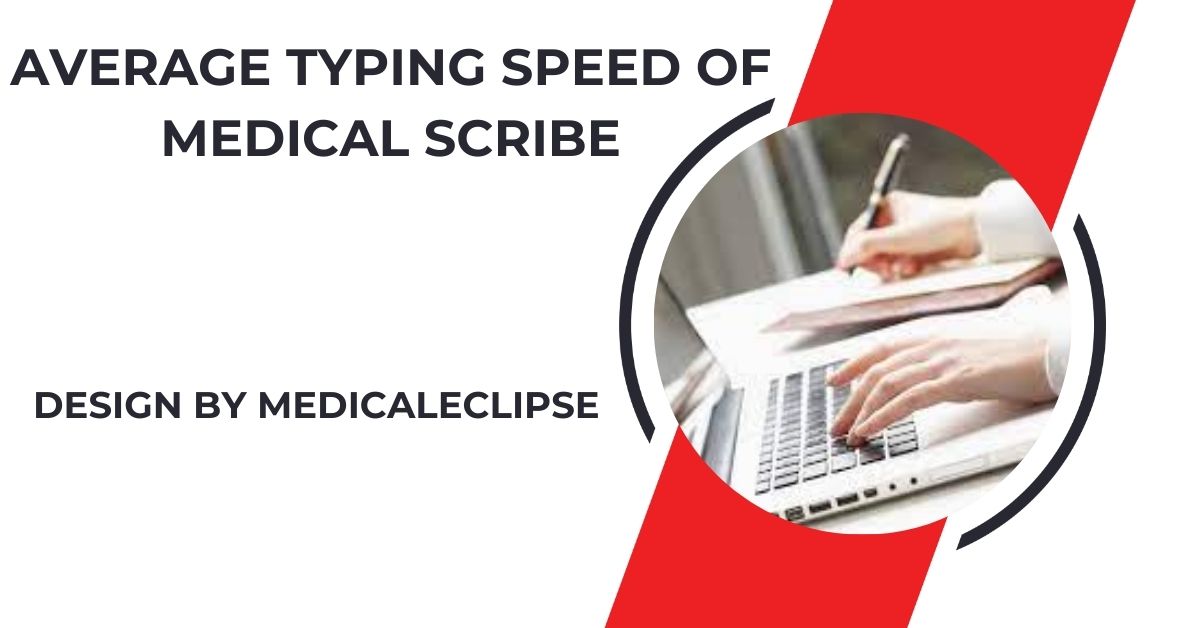Medical scribes typically need a typing speed of 65-80 WPM, especially in fast-paced environments like ERs, where accuracy and speed are critical.
In this guide, we’ll cover the average typing speed required of medical scribes, why it’s essential, factors that can impact a scribe’s typing performance, and practical tips to help aspiring scribes boost their skills.
The Role of a Medical Scribe in Healthcare:

Medical scribes work directly with healthcare providers, often shadowing them during patient interactions. They’re responsible for documenting the patient-provider encounter in real-time and inputting data into Electronic Health Records (EHRs). The demand for medical scribes has surged as more clinics and hospitals adopt EHRs and seek ways to reduce administrative burdens on healthcare providers.
Core Responsibilities of a Medical Scribe:
- Accurately documenting medical histories, physical exams, and treatment plans.
- Recording physician-patient conversations and diagnoses.
- Updating patient records in real-time as lab results, imaging, or additional consultations become available.
- Assisting physicians by managing clerical tasks, allowing more face-to-face time with patients.
Why Typing Speed Matters for Medical Scribes In a role where documenting real-time interactions is key, a scribe must keep up with the pace of conversations without interrupting patient care. Thus, typing speed directly impacts their ability to maintain quality records in a fast-paced environment.
Average Typing Speed Requirements for Medical Scribes:
Typing speeds are crucial because medical scribes must listen, understand, and type simultaneously during patient interactions. While typing speeds can vary depending on the healthcare environment, a general guideline is as follows:
- Primary Care and General Clinics: 65–75 WPM
- Urgent Care Facilities: 70–80 WPM
- Emergency Departments and Specialized Clinics: 80–90+ WPM
Also Read: Broward Health Medical Center – What You Need to Know!
Comparison with Other Professions
- General Workforce Average: 40 WPM
- Experienced Typists: 80–100+ WPM
- Court Reporters: 225 WPM (using stenography)
The typical 65–80 WPM typing speed of a medical scribe is high compared to the general workforce average, which reflects the role’s high demands. In high-pressure settings like emergency rooms, faster speeds may be required to keep up with rapidly changing conditions.
Why a High Typing Speed Is Important for Medical Scribes:

Medical scribing is unique in that it combines speed with medical knowledge and accuracy. Fast typing speeds allow scribes to complete notes and records in real time, which leads to improved documentation quality and reduced stress for healthcare providers.
Benefits of High Typing Speed in Medical Scribing
- Real-Time Efficiency: Medical scribes ensure that no detail is missed, allowing physicians to move smoothly between patients.
- Accuracy in Documentation: Faster typing, when paired with medical knowledge, allows scribes to document everything accurately without rework.
- Improved Patient-Provider Interaction: Scribes handle the documentation, giving providers the freedom to engage more effectively with patients.
- Reduced Documentation Backlogs: Faster scribes help minimize the time required to update patient records, reducing backlog and improving healthcare facility efficiency.
In addition to speed, accuracy is essential in this role. Mistakes in documentation could impact patient care, insurance claims, and medical records. Therefore, scribes must strive for high typing speed without sacrificing accuracy.
Medical Scribe Wpm:
A medical scribe’s Words Per Minute (WPM) typing speed is critical for accurate and efficient documentation. Ideally, a scribe should achieve 60-80 WPM or higher to keep pace with fast-paced medical environments. High typing speed ensures timely and precise recording of patient encounters, allowing healthcare professionals to focus on patient care.
Factors Influencing Typing Speed for Medical Scribes
While many scribes aim to reach typing speeds of 80+ WPM, several factors influence individual performance:
- Experience Level: With more experience, scribes develop familiarity with medical jargon and workflow, which naturally improves typing speed.
- Knowledge of Medical Terminology: Scribes with a solid grasp of medical terminology can transcribe information more quickly, reducing pauses for spelling or clarification.
- Environment and Case Complexity: Emergency room scribes, for example, often encounter complex cases requiring higher speeds to capture comprehensive details in short periods.
- Training and Software Familiarity: Proficiency with EHRs and scribing software improves efficiency, allowing scribes to navigate menus, templates, and shortcuts faster.
Also Read: How To Get Dental Implants Covered By Medical Insurance – Dental Implants Insurance Guide!
Strategies to Improve Typing Speed for Aspiring Medical Scribes:
Improving typing speed is a goal many scribes work towards before starting the role. Here are effective strategies to help increase both speed and accuracy:
- Practice Typing with Real Medical Content: Many online typing programs offer typing drills. Typing exercises that include medical terminology can be beneficial for scribes.
- Typing Software and Speed Tests: Platforms like TypingClub, Keybr, and Typing.com offer structured typing practice to improve speed over time. Aim for short, frequent sessions (15-20 minutes daily) focusing on accuracy first.
- Shadowing and Observation: Many scribing organizations offer shadowing opportunities that allow aspiring scribes to observe real-time documentation. Watching experienced scribes helps newcomers develop a feel for the pace and expectations.
- Familiarity with EHR Systems: Gaining proficiency in EHR platforms (Epic, Cerner, or Athenahealth) commonly used in medical facilities can provide a significant speed advantage once on the job.
- Keyboard Techniques: Typing without looking at the keyboard can dramatically improve speed and accuracy. Practice keeping your fingers on the home row keys (A, S, D, F, J, K, L, ;).
The Typing Speed Requirement for Various Healthcare Settings:
Each healthcare setting has unique demands for typing speed. Let’s explore common settings and the typing speeds expected:
- Primary Care Clinics: In primary care, scribes typically need a moderate typing speed (65-75 WPM) to document detailed patient interactions without rushing.
- Urgent Care Clinics: Here, faster typing (70-80 WPM) is often necessary due to the higher patient volume and varied cases.
- Specialized Clinics: Scribes in cardiology or orthopedics may need a faster typing speed (75-85 WPM) to capture specific medical information.
- Emergency Departments: ER scribes generally require the highest speeds (85+ WPM) due to the fast-paced, unpredictable environment and the need to document rapidly changing conditions.
The Future of Medical Scribing and Typing Efficiency:

As technology advances, some aspects of medical scribing are evolving. For instance, voice recognition software is becoming more sophisticated, and some facilities are implementing AI-driven scribe tools to supplement or support human scribes. However, a medical scribe’s role is still critical, as human scribes provide context, ensure accuracy, and adapt to complex medical situations that AI currently struggles to manage.
Furthermore, because the demand for healthcare services is growing, many healthcare facilities continue to rely on skilled scribes to manage patient documentation efficiently. For those entering the field, investing time in improving typing skills is a reliable way to enhance career prospects in this growing profession.
Summary: Why Typing Speed Matters for Medical Scribes
To excel as a medical scribe, the average typing speed of 65-80 WPM is a minimum expectation, with higher speeds often required in high-intensity settings. A scribe’s typing speed is not only a measure of efficiency but also directly impacts documentation accuracy, patient satisfaction, and provider efficiency.
As healthcare demands increase, the need for scribes who can manage fast, accurate documentation remains high. By improving typing skills, familiarizing themselves with medical terminology, and gaining experience with EHRs, aspiring medical scribes can set themselves up for success in this rewarding field.
FAQs
1. What is the average typing speed required for medical scribes?
Medical scribes typically need a typing speed of 65-80 WPM, especially in high-intensity settings like emergency rooms.
2. Why is typing speed important for a medical scribe?
Typing speed is critical because it allows scribes to document real-time interactions accurately without delaying patient care.
3. How does the healthcare environment affect typing speed needs?
Different settings require different speeds; for example, ERs may require 85+ WPM, while primary care clinics often need around 65-75 WPM.
4. What factors impact a scribe’s typing speed?
Experience, knowledge of medical terminology, familiarity with EHRs, and the complexity of cases can all influence typing speed.
5. How can medical scribes improve their typing speed?
Practicing with medical content, using typing tools, shadowing professionals, and familiarizing themselves with EHR systems can boost typing efficiency.
conclusion
Whether you’re an aspiring medical scribe or a current professional looking to improve, focusing on typing speed, accuracy, and familiarity with medical terms can make you invaluable to any healthcare team. Through dedication and practice, reaching an efficient typing speed is achievable, and the benefits will extend throughout your scribing career and beyond.

Leave a Reply